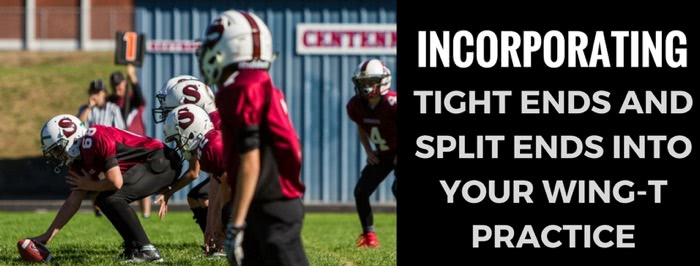Incorporating TEs and SEs into your Wing-T Practice

A reader recently asked about some ideas for incorporating tight ends and split ends (wide receivers) more effectively into the Wing-T practice.
My short answer: tight ends are easy to incorporate, split ends take some creativity.
Typical Personnel Depth
Just about every year I’ve coached youth or middle school football, I’ve had two TEs and four or more SEs. We are able to include smaller, less athletic kids in the SE rotation but note that we work hard not to “hide” these kids there. We want to incorporate them into the offense and hold them accountability for doing their job. And their job, 98% of the time, is to block well.
Tight Ends
Our TEs will spend most of their time with the offensive line. They need to be able to execute every single block that the rest of our line executes: gap, down, reach, on, backer, and pull/lead. In this regard they are indistinguishable from the OL team and this is their true home.
If I had the luxury of an extra OL coach for more breakout work, I would have the TEs also work on cutoff blocks for sweeps away from them. We often run out of a SE over formation and we flip our quick tackle and TE to stay within league rules (our QT might not be an eligible receiver, so we go tackle over and replace the tackle with the TE). Given that we run a lot of jet and down sweep out of this formation, the TE job is to cutoff at 7–10 yards playside.
In a given week of 6 hours of practice, we set aside about 30–40 minutes for our passing game and the TEs join the backs and SEs. The OL then works on either inside run game or pass protection.
Split Ends
There’s a reason your SEs (wide receivers) are called “wide guards”. Much of the passing game in the Wing-T does not heavily involve the SE, and many youth QBs are not equipped to make the throws necessary to include them when you try. Here are some things we do to help out:
- We run a lot out of a SE “over” formation and run sweeps to their side. This makes the SE blocking very important and gives you film to look at and reasons to praise your SEs. It also spreads the corner out making the RB reads a bit easier than when the CB is directly over the wing.
- This season we added a simple RPO off of the belly / ISO play with a hard slant from the SE. When I write out my practice script, I include intentional calls to throw the slant. This keeps the SEs on their game and aware of the possibility of a pass. This becomes an easy direct call in a game when you want to give the SE a relatively high percentage quick pass option.
- Include a quick passing game (I recommend the materials from Win with the Pass) and consider running with a spread formation from time to time and go with a 2 SE personnel package (without a TE). Again, these are high percentage plays and can directly involve the SEs in your attack. And you can still run a lot of your weak-side plays from this formation.
- Lastly, and this is to reinforce the first point: find reasons to call out good play from SEs after reviewing game film. Do it publicly in front of the rest of the team.